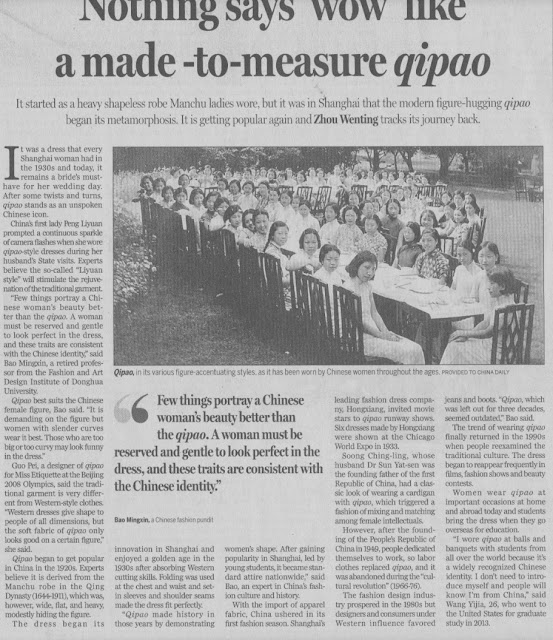太太's Closet
 |
| China Daily, 2015 June 19 |
Qipao for the modern girl
If you love all things Asian, here's good news for you. Stores have opened recently in Singapore, one selling the Chinese qipao
If people on the street aren't going where the culture is, perhaps culture and history can be brought to them - 'curated' appealingly in a stylish boutique rather than a stuffy museum.
Visitors to such a boutique can admire, touch, feel, try on and best of all, buy. And that, is a great way into a Singaporean's heart, believes broadcast journalist-turned-designer Tan Sheau Yun, who opened her fashion boutique Tan Tan last year.
Discovering culture through fashion: Ms Tan wearing one of her own creations
'Visiting museums isn't a Singaporean thing,' she says, based on her experience as long-time docent (volunteer guide) with the Asian Civilisations Museum and the former Singapore History Museum. 'And those who go are already converts,' she adds.
So, armed also with a post-graduate diploma in Asian Arts from the British Museum, Ms Tan has managed to marry her business degree and knowledge and love of Chinese arts for the fashion business.
While there has been a 'revival' and re-interpretation of the qipao since the movie In the Mood for Love seared cinema screens six years ago, Ms Tan is giving a fresh and quirky take on the traditional Chinese qipao silhouette, with the inspiration for most designs drawn from from the 1950s-70s.
Tops and dresses are cut out from the qipao template, with little twists and embellishments here and there - not just for the look, but for comfort and ease of wear for the modern girl.
Fabrics she uses include Indian sari fabric, English-country floral prints; shantung silk and even vintage material when she can get her hands on them.
A dress can look like a traditional qipao in front, while the back of the skirt could be in box pleats - so the modern girl need not feel restricted in a fitted skirt. Ms Tan maintains that traditionally, the qipao wasn't as figure-hugging as the way actress Maggie Cheung wore hers.
For something contemporary, there are 'day dresses' with the traditional qipao top but skirts in tulip shapes or pleats. And ladies would be most happy to know that while sizes range from US size two to 10, Ms Tan labels them according to Chinese dynasty names - Xia, Shang, Zhou, Qin and Han. Tang and Song sizes are customised to order.
'Nobody really likes to know that they're wearing an XL or XXL, so we use dynasty names instead,' she says.
Now that's a fresh approach in the fashion business, which is surprising - or maybe not - given that Ms Tan, 34, doesn't have a fashion design background. Her approach to design is more rooted in her childhood exposure to Chinese history and arts.
Her parents were educated in Taiwan, and she vividly remembers her father getting her to memorise ancient Chinese poetry - the Tang dynasty poem about the Romance of Yang Guifei, no less - when she was in kindergarten. Her mother studied art in Taipei and taught it when she returned to Singapore. 'I remember going with them on trips to Taiwan, and my mother had classmates who were curators in the National Palace Museum in Taipei. Even at a young age, I could sense their passion for the arts,' Ms Tan recalls.
After graduating in business studies at the University of Indiana, she worked as a journalist-producer with Mediacorp's Channel Eight for six years, mainly producing current affairs features, several of which won Mediacorp awards.
Three years ago, the former Singapore Chinese Girls' School student decided to quit broadcasting and take up a British Museum scholarship, spending nine months learning about the decorative arts of Islamic, Indian and Chinese cultures.
When she returned to Singapore, she figured a good way to induct a person into Chinese history was through fashion - by making it relevant to daily life. Her debut collection sold successfully at a private sale, and Tan Tan - the boutique that wants to inspire Singaporeans to discover their heritage - soon came about.
'A lot of my customers bought their first qipao from me,' she says with satisfaction. Cotton qipaos are priced from $150, with silk ones around $300. Tops range from $55 to $200. There are also T-shirts - a later addition, and she steers clear of propaganda art because it's overused, she says - and plastic brooches in the style of Chinese paper-cuts.Eventually, Ms Tan hopes to expand her design range to include lifestyle products, especially as she has a soft spot for ceramics. 'Fashion is only a starting point for me, and I want to take it further,' she says. With a Chinese twist, of course. - SINGAPORE BUSINESS TIMES 3 Feb 2007 by Cheah Ui-Hoon and Corinne Kerk






No comments:
Post a Comment